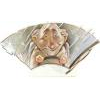 Do you struggle to adjust to the road conditions as the weather changes in the lead up to winter? Daylight hours decrease, traction conditions change rapidly and slower speeds may be necessary to remain safe. Make sure that all your lights are on when necessary and let's drive for the season.
Do you struggle to adjust to the road conditions as the weather changes in the lead up to winter? Daylight hours decrease, traction conditions change rapidly and slower speeds may be necessary to remain safe. Make sure that all your lights are on when necessary and let's drive for the season.

Fewer Daylight Hours
Driving in the darkness is riskier than driving in daylight. Having to rely only on the area lit by your headlights for driving information significantly reduces your ability to see and react.
It's easy to drive faster than you can see when using low beam headlights.
Sunrise and Sunset
The sun is low on the horizon at commute times making it difficult to see in the heavy traffic. If you can't change your commute time by a few minutes to avoid this, make sure that you are protected from glare.
Keep your windshield clean, use sunglasses and don't forget your sun visor.
Wildlife on the Road
According to the Wildlife Collision Prevention Program, 80% of wildlife collisions in B.C. involve deer. November is the month with the greatest risk as the annual rut can produce erratic and aggressive behaviour.
These animals are most active at dawn and dusk which can coincide with the daily commute.
Leaves on the Road
Wet or frozen leaves on the road can be very slippery and will hide hazards like potholes. Even a carpet of dry leaves is slicker than dry asphalt.
Wet Roads, Frost and Black Ice
Clean dry roads that we enjoy in summer are fewer in the fall. Water, whether in liquid or frozen form, reduces the available traction. This means that stopping and steering can become more difficult. Adjust your speed to take poor conditions into account.
Too Fast for Road Conditions
You are probably tired of hearing it by now, but the posted speed limits are for good driving conditions.
When the conditions are no longer ideal drivers who fail to reduce speed may receive a ticket for driving at a speed that is inappropriate for road conditions. The penalty is $167 and 3 penalty points.
Share This Article
In the lower mainland where I live there are electronic variable speed limit overhead signs on some highways. They almost always show the posted speed limit. In my experience the signs only change for traffic congestion ahead.
However I have seen horrible driving conditions on the very highways these electronic units are situated and they NEVER show a lower speed limit. It's very much like the weatherperson who, having decided what the forecast will be, fails to look out the window to see what the weather actually is.
Why don't these electronic variable signs show a lower speed limit when the road conditions are less than optimal?
- Log in to post comments
I have only driven past these variable speed signs once in my life and it was under good conditions.
TranBC suggests that one job for these signs is to tell drivers to slow down for weather conditions. The discussion thread in that post seem to find the same thing that you have experienced.
- Log in to post comments
- Log in to post comments

Electronic Speed Limit Signs